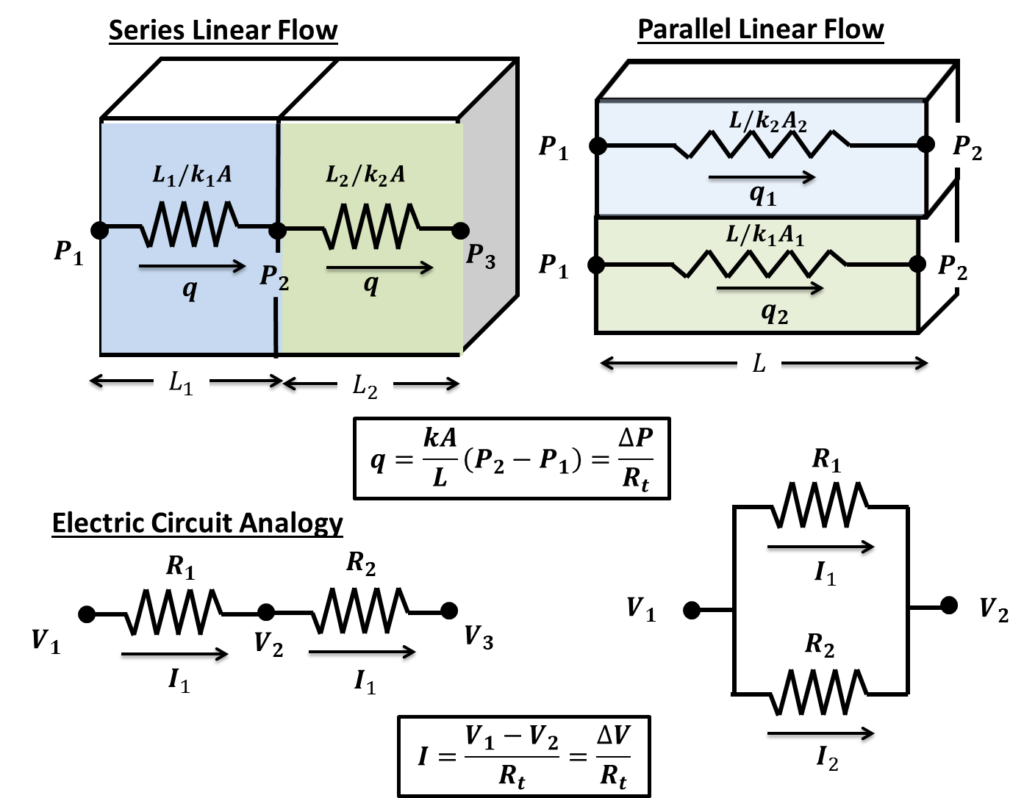Understanding the permeability distribution in the reservoir is critical to forecasting the depletion process and predicting the estimated ultimate recovery from a well. In many cases, the reservoir is heterogeneous and contains distinct layers with different permeabilities. One method of understanding the permeability distribution is through core analysis. It is common to compute an average permeability from a core sample and use this value to represent the flow characteristics of the entire reservoir. There are two methods we will investigate of calculating average permeability:
- Weighted-Average permeability (Parallel Flow)
- Harmonic-Average permeability (Series Flow)
Before I jump into the math, the derivations will make a lot more sense if you can associate flow through layers with that of resistors in series and parallel in electric circuits as given by Ohm’s law. The figure below depicts this analogy:

From the figure above, it is clear that flow layers in series can be treated like a resistors in series. Similarly, flow units in parallel can be treated like resistors in parallel. To enforce this analogy even further, I will relate the mathematical expressions for Ohm’s and Darcy’s Law. Ohm’s law can be expressed as:
![Rendered by QuickLaTeX.com \[ I = \frac{V_1-V_2}{R_e} = \frac{\triangle V}{R_e} \]](https://topdogengineer.com/wp-content/ql-cache/quicklatex.com-14a2ffb33db81199006a6539b4a922b2_l3.png)
where,
![]() : is the current flowing through an element
: is the current flowing through an element
![]() : is the voltage across an element
: is the voltage across an element
![]() : is the electrical resistance across the element
: is the electrical resistance across the element
Similarly, Darcy’s Law can be written as:
![Rendered by QuickLaTeX.com \[ q = \frac{P_1-P_2}{R_t} = \frac{\triangle P}{R_t} \]](https://topdogengineer.com/wp-content/ql-cache/quicklatex.com-029672b1027fe8769fe89de5d6355544_l3.png)
where,
![]() : is the flow rate through a flow unit
: is the flow rate through a flow unit
![]() : is the pressure difference across a flow unit
: is the pressure difference across a flow unit
![]() : is the flow resistance across a flow unit (
: is the flow resistance across a flow unit (![]() )
)
By now it should be clear that flow rate (![]() ) can be treated like current (
) can be treated like current (![]() ), the pressure difference (
), the pressure difference (![]() ) can be treated like a voltage difference (
) can be treated like a voltage difference (![]() ), and the flow resistance (
), and the flow resistance (![]() ) can be treated like electrical resistance (
) can be treated like electrical resistance (![]() ). The table below summarizes the analogies:
). The table below summarizes the analogies:
| Darcy’s Parameter | Ohm’s law Equivalent |
| Flow Rate, |
Current, |
| Differential Pressure, |
Voltage Difference, |
| Flow Resistance, |
Resistance, |